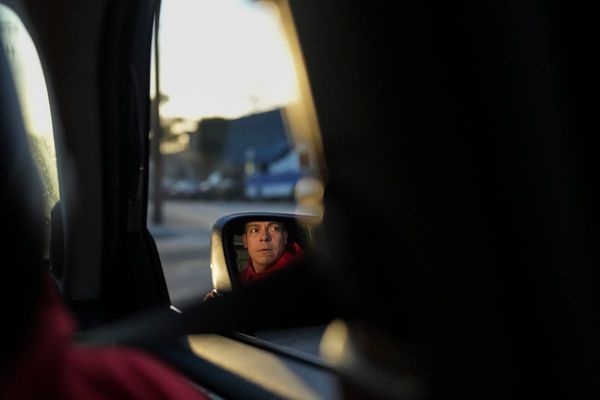You wake up to a cacophony of birdsong as the sky lightens. Propping yourself on pillows, you scan the wild African landscape out the front screen of the room. An impala noiselessly strides past while a bird swoops into view, a flash of shimmering blue, orange and green.
Hot tea awaits you on the veranda. As you sip, you imagine what you’ll see on safari today. Perhaps a mother lion and her cubs or a troop of playful baboons.
Who would expect such luxury in the Tanzanian wilderness? But such is a typical morning at Honeyguide Tarangire Camp, a tent-lodging concept that puts safari goers closer to the wildlife they come to view. The camp’s 10 tents aren’t the poles-and-nylon-fabric variety but rather cozy suites with a range of creature comforts – and with the feel of being in the wild because, well, they are.
Our group of six travelers signed up for a night at Honeyguide as part of a two-day safari last summer. Before it, we had completed the long trek to the top of Mount Kilimanjaro, and now we needed some winding down time. On day one, our safari driver took us to the Ngorongoro Crater, where we spotted at least 15 different animals and even more species of birds as we jostled along trying to hold our binoculars steady. By the time we arrived at the camp, the night sky was displaying a burst of stars.
Honeyguide is one of the latest in a series of small resorts to open within Tarangire National Park in northern Tanzania. The park is known for its distinctive baobab trees and abundant elephant herds, but other four-legged inhabitants are as varied as giraffes, zebras, wildebeests, lions and jackals. The camp is a tidy oasis amid the untamed landscape.
Camp manager Raymond Teekishe welcomed our group, handing each of us a flashlight. Affable and witty, he won us over immediately with his smile and continual one-liners. Dinner would be ready soon, but first his staff would show us to our assigned tents. I was slightly alarmed to learn that these escorts were guiding us as a precaution, in case a wandering nocturnal animal was a little too curious. My heart was beating fast during the short walk in pitch darkness. But once inside the zipped-up tent, I felt perfectly safe.
The tents are built on platforms with a deck surrounding their four sturdy canvas walls. One of the walls zips open to a screen, providing a front-yard view of the bush. Always seeking to be one with nature, my tentmate and I kept our screen open for the night and were rewarded with the distant sound of hyenas “laughing” and, in the morning, a sun rising to a soundtrack of birds trying to outdo one another.
Tents can fit up to three adults, or two adults plus two children. In addition to the well-dressed beds, there’s a separate bathroom and shower area, a table and chairs, a couch, and comfy outdoor furniture on the veranda. Other amenities are free Wi-Fi, a storage safe for valuables and mosquito netting draped over the beds in a pleasing but practical way. It’s glamping at its finest.
Raymond, who also helped design and construct the camp, spent time orienting each of us in our tents and put us at ease about being in the wild. His instructions, mixed with clever jokes, made us laugh beyond a polite chuckle. Raymond takes pride in Honeyguide’s eco-friendly features – following a trend among resorts in other tourist-friendly African countries. The camp uses solar energy to power the outlets and heat the water. We were asked to help out by limiting our water use, including letting the shower water stream into a bucket while it heated up so that the saved water could be used later for other purposes.
Once we were settled, we gathered at a campfire for pre-dinner beverages, then assembled around a table in the open night air. The meal was a showcase of locally sourced traditional dishes such as carrot and ginger soup and beef curry with fried coconut rice. Eating by candlelight, I could barely see what was on my plate, but the flavors and textures were as delightful as the food any high-quality indoor restaurant would serve. This was no pork ‘n’ beans supper.
The next morning our group gathered for a breakfast that offered us several enticing options. Then we packed up and climbed back into our safari vehicle, eager to get some up-close photos of Tarangire’s wildlife before heading back to the airport.
Honeyguide Tarangire Camp shares its name with a species of bird found in Africa that is known for interacting with humans. Over centuries, the stories go, the honeyguides have led people to bee colonies for collecting honey, and the birds benefit by feasting on the beeswax that is left behind. Such synergy makes for an apt comparison with the Honeyguide camp – a band of weary travelers are led to a sweet treasure hidden in the African wild.
———
If you go
Honeyguide Tarangire Camp
Getting there: Fly into Kilimanjaro International Airport or Arusha Airport, where tour coordinators pick up clients for the three-hour drive from either airport.
Activities: The camp offers its own safaris but also works with other outfitters. Besides safaris, hot air balloon rides and cultural tours of the Maasai people are available in the area.
Info: www.honeyguidecamp.com
Also: Honeyguide has two camps in South Africa in addition to Tanzania’s.
———







